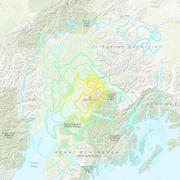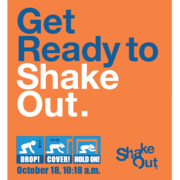Due to a lapse in appropriations, the majority of USGS websites may not be up to date and may not reflect current conditions. Websites displaying real-time data, such as Earthquake and Water and information needed for public health and safety will be updated with limited support. Additionally, USGS will not be able to respond to inquiries until appropriations are enacted. For more information, please see www.doi.gov/shutdown
Earthquake Hazards
Home
The USGS monitors and reports on earthquakes, assesses earthquake impacts and hazards, and conducts targeted research on the causes and effects of earthquakes. We undertake these activities as part of the larger National Earthquake Hazards Reduction Program (NEHRP), a four-agency partnership established by Congress.
The Hayward Fault—Is It Due for a Repeat of the 1868 Earthquake?

On October 21, 1868, a magnitude 6.8 earthquake struck the San Francisco Bay area. Although the region was sparsely populated, the quake on the Hayward Fault was one of the most destructive in California’s history.
Read MoreNew Methods for Dating and Sequencing Ancient Earthquakes

Complex geologic sites, like those between the fault segments along the Wasatch fault zone in Utah, make the dating and ordering past earthquakes a difficult task. Two new methods were used to make this task easier and to get better results.
Read StoryExplore the Earthquake Hazards Program
Latest and historical earthquakes, hazards information, educational resources, maps, seismographic stations and real-time recording, current research in plain language, data, software and derived products.
Earthquake Notification Service and Web Services/Feeds
Earthquake Lists and Statistics
Earthquake Information by State or World Region
Explore EarthquakesNews
2018 Anchorage Earthquake
A magnitude 7.0 earthquake struck north of Anchorage, Alaska, on November 30, 2018, at 8:29 a.m. local time (17:29:28 UTC). For the most up-to-date information, please visit the USGS event page, and for estimates of casualties and damage, visit the USGS Prompt Assessment of Global Earthquakes for Response (PAGER) website.
The Hayward Fault—Is It Due for a Repeat of the Powerful 1868 Earthquake?
By Thomas M. Brocher, Jack Boatwright, James J. Lienkaemper, Carol S. Prentice, David P. Schwartz, and Howard Bundock
Drawn from: USGS Fact Sheet 2018-3052
The Great ShakeOut! -- 2018 Edition
Do you know what to do the moment the ground starts shaking? Drop, Cover, and Hold On!
Publications
On the potential duration of the aftershock sequence of the 2018 Anchorage earthquake
Currently, an aftershock sequence is ongoing in Alaska after the magnitude 7.0 Anchorage earthquake of November 30, 2018. Using two scenarios, determined with observations as of December 14, 2018, this report estimates that it will take between 2.5 years and 3 decades before the rate of aftershocks decays to the rate of earthquakes that were...
Michael, Andrew J.Earthquakes induced by hydraulic fracturing are pervasive in Oklahoma
Wastewater disposal is generally accepted to be the primary cause of the increased seismicity rate in Oklahoma within the past decade, but no statewide analysis has investigated the contribution of hydraulic fracturing (HF) to the observed seismicity or the seismic hazard. Utilizing an enhanced seismicity catalog generated with multi‐station...
Skoumal, Robert J.; Ries, Rosamiel; Brudzinski, Michael R.; Barbour, Andrew J.; Currie, Brian S.Microseismic events associated with the Oroville Dam spillway
On 14 February 2017, two small (equivalent MD 0.8 and 1.0) seismic events occurred in proximity to the Oroville Dam in the Sierra Nevada foothills, California. To examine possible causal relationships between these events and reservoir operations, including the spillway failure starting prior to these events, we applied a new optimized template...
Skoumal, Robert J.; Dawson, Phillip B.; Hickman, Stephen H.; Kaven, J. Ole





